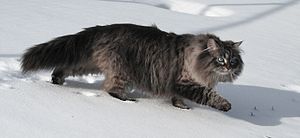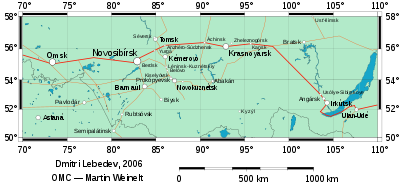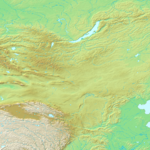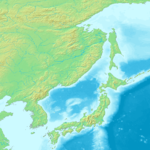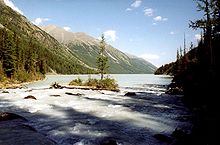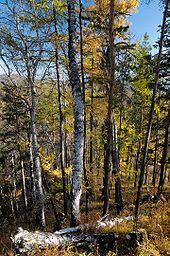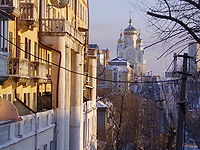- Siberia
-
This article is about Siberia as a whole. For the federal district, see Siberian Federal District. For other uses, see Siberia (disambiguation).
Coordinates: 60°0′N 105°0′E / 60°N 105°E
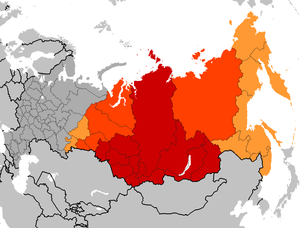 Siberian Federal District Geographic Russian Siberia Historical Siberia (and present Siberia in some usages)
Siberian Federal District Geographic Russian Siberia Historical Siberia (and present Siberia in some usages)
Siberia (pronounced /saɪˈbɪəriə/; Russian: Сибирь, tr. Sibir' [sʲɪˈbirʲ] (
 listen)) is an extensive region constituting almost all of Northern Asia. Comprising the central and eastern portion of the Russian Federation, it was part of the Soviet Union (USSR) from its beginning, as its predecessor states, the Tsardom of Russia and the Russian Empire, conquered it during the 16th to 19th centuries.
listen)) is an extensive region constituting almost all of Northern Asia. Comprising the central and eastern portion of the Russian Federation, it was part of the Soviet Union (USSR) from its beginning, as its predecessor states, the Tsardom of Russia and the Russian Empire, conquered it during the 16th to 19th centuries.Encompassing much of the Eurasian Steppe, the territory of Siberia extends eastward from the Ural Mountains to the watershed between the Pacific and Arctic drainage basins, and southward from the Arctic Ocean to the hills of north-central Kazakhstan and the national borders of Mongolia and China.[1] Siberia makes up about 77% of Russia's territory (13.1 million square kilometres), but has only 28% (40 million people) of Russia's population.
Contents
Etymology
Some sources say that the word Siberia originates from the Turkic for "sleeping land". Another version is that this name was the ancient tribal name of the Sabirs, Turkic nomads later assimilated to Siberian Tatars. The modern usage of the name appeared in the Russian language after the conquest of the Siberian Khanate.[2]
Borders and administrative division
The term "Siberia" has a long history. Its meaning has gradually changed during ages. Historically, Siberia was defined as the whole part of Russia to the east of Ural Mountains, including the Russian Far East. According to this definition, Siberia extended eastward from the Ural Mountains to the Pacific coast, and southward from the Arctic Ocean to the border of Russian Central Asia and the national borders of both Mongolia and China.[3]
Soviet-era sources (Great Soviet Encyclopedia and others)[4] and modern Russian ones[5] usually define Siberia as a region extending eastward from the Ural Mountains to the watershed between Pacific and Arctic drainage basins, and southward from the Arctic Ocean to the hills of north-central Kazakhstan and the national borders of both Mongolia and China. By this definition, Siberia includes the federal subjects of the Siberian Federal District, and some of the Urals Federal District, as well as Sakha (Yakutia) Republic, which is a part of the Far Eastern Federal District. Geographically, this definition includes subdivisions of several other subjects of Urals and Far Eastern federal districts, but they are not included administratively. This definition excludes Sverdlovsk Oblast and Chelyabinsk Oblast, both of which are included in some wider definitions of Siberia.
Other sources may use either a somewhat wider definition that states the Pacific coast, not the watershed, is the eastern boundary (thus including the whole Russian Far East)[6] or a somewhat narrower one that limits Siberia to the Siberian Federal District (thus excluding all subjects of other districts).[7] In Russian, the word for Siberia is never used as a substitute for the name of the federal district.
Major cities
Major cities include:
History
The Siberian Traps was formed by one of the largest known volcanic events of the last 500 million years of Earth's geological history. The event continued for a million years and is considered the likely cause of the "Great Dying" about 250 million years ago,[8] which is estimated to have killed 90% of species existing at the time.[9]
At least three species of humans lived in southern Siberia around 40,000 years ago: H. sapiens, H. neanderthalensis, and an unknown type of hominin, nicknamed "Woman X" for the time being.[10]
Siberia was occupied by differing groups of nomads such as the Yenets, the Nenets, the Huns, the Iranian Scythians, and the Turkic Uyghurs. The Khan of Sibir in the vicinity of modern Tobolsk was known as a prominent figure who endorsed Kubrat as Khagan in Avaria in 630. The area was conquered by the Mongols early in the 13th century. With the breakup of the Golden Horde, the autonomous Siberia Khanate was established in late 14th century. The Yakuts migrated north from their original area of settlement in the vicinity of Lake Baikal under the pressure of the Mongol expansion during the 13th to 15th century.[11]
The growing power of Russia to the west began to undermine the Siberian Khanate in the 16th century. First, groups of traders and Cossacks began to enter the area, and then the Russian army began to set up forts further and further east. Towns like Mangazeya, Tara, Yeniseysk, and Tobolsk sprang up, the latter being declared the capital of Siberia. At this time, Sibir was the name of a fortress at Qashlik, near Tobolsk. Gerardus Mercator in a map published in 1595 marks Sibier both as the name of a settlement and of the surrounding territory along a left tributary of the Ob.[12]
By the mid-17th century, the Russian-controlled areas had been extended to the Pacific. The total Russian population of Siberia in 1709 was 230,000.[13]
Siberia remained a mostly undocumented and sparsely populated area. During the following few centuries, only a few exploratory missions and traders entered Siberia. The other group that was sent to Siberia consisted of prisoners exiled from western Russia or Russian-held territories like Poland (see katorga). In the 19th century, around 1.2 million prisoners had been sent to Siberia.[14]
The first great modern change to Siberia was the Trans-Siberian railway, constructed in 1891–1916. It linked Siberia more closely to the rapidly-industrializing Russia of Nicholas II. From 1801 to 1914, an estimated 7 million settlers moved from European Russia to Siberia, 85% during the quarter-century before World War I.[15] From 1859 to 1917, over half a million people moved to the Russian Far East.[16] Siberia is filled with natural resources and during the 20th century large scale exploitation of these was developed, and industrial towns cropped up throughout the region.[17]
In the times of the Soviet Union, the earlier katorga system of penal labor camps was replaced by the new one, administered by the GULAG state agency.[18] According to official Soviet estimates, more than 14 million people passed through the Gulag from 1929 to 1953, with a further 7 to 8 million being deported and exiled to remote areas of the Soviet Union (including entire nationalities in several cases).[19] 516,841 prisoners died in camps from 1941 to 1943[20] due to food shortages caused by World War II. At other periods, mortality was comparatively lower.[21]The size, scope, and scale of the GULAG slave labor camp system remains a subject of much research and debate; for example, Australian professor Stephen Wheatcroft argues that these penal camps were neither as large nor as deadly as is often claimed.[22] Many Gulag camps were positioned in extremely remote areas of north-eastern Siberia. The best known clusters are Sevvostlag (The North-East Camps) along Kolyma river and Norillag near Norilsk, where 69,000 prisoners were kept in 1952.[23] Major industrial cities of the Northern Siberia, such as Norilsk and Magadan, were originally camps built by prisoners and run by ex-prisoners.[24]
Geography
TaklamakanHindukushPhysical map of Northern Asia. With an area of 13.1 million km² (5.1 million square miles), Siberia makes up roughly 77% of the total area of Russia. Major geographical zones include the West Siberian Plain and the Central Siberian Plateau. Siberia covers almost 10% of Earth's land surface (14,894,000 km²).
Eastern and central Sakha comprise numerous north-south mountain ranges of various ages. These mountains extend up to almost three thousand metres in elevation, but above a few hundred metres they are almost completely devoid of vegetation. The Verkhoyansk Range was extensively glaciated in the Pleistocene, but the climate was too dry for glaciation to extend to low elevations. At these low elevations are numerous valleys, many of them deep, and covered with larch forest except in the extreme north, where tundra dominates. Soils are mainly Turbels and the active layer tends to be less than one metre deep except near rivers.
The highest point in Siberia is the active volcano Klyuchevskaya Sopka, in the Kamchatka peninsula. Its peak is at 4,649 metres (15,253 ft).
Mountain ranges
- Altai Mountains
- Anadyr Range
- Baikal Mountains
- Chamar-Daban
- Chersky Range
- Dzhugdzhur Mountains
- Gydan Mountains
- Koryak Mountains
- Sayan Mountains
- Tannu-Ola Mountains
- Ural Mountains
- Verkhoyansk Mountains
- Yablonoi Mountains
Lakes and rivers
- Anabar River
- Angara River
- Indigirka River
- Irtysh River
- Kolyma River
- Lake Baikal
- Lena River
- Lower Tunguska River
- Novosibirsk Reservoir
- Ob River
- Popigay River
- Stony Tunguska River
- Upper Angara River
- Uvs Nuur
- Yana River
- Yenisei River
Grasslands
- Ukok Plateau — part of a UNESCO World Heritage Site[25]
Geology
The West Siberian Plain consists mostly of Cenozoic alluvial deposits and is somewhat low-lying. Many of the deposits on this plain result from ice dams; having reversed the flow of the Ob and Yenisei Rivers, so redirecting them into the Caspian Sea (perhaps the Aral as well). It is very swampy and soils are mostly peaty Histosols and, in the treeless northern part, Histels. In the south of the plain, where permafrost is largely absent, rich grasslands that are an extension of the Kazakh Steppe formed the original vegetation (almost all cleared now).
The Central Siberian Plateau is an extremely ancient craton (sometimes named Angaraland) that formed an independent continent before the Permian (see Siberia (continent)). It is exceptionally rich in minerals, containing large deposits of gold, diamonds, and ores of manganese, lead, zinc, nickel, cobalt and molybdenum. Much of the area includes the Siberian Traps which is a large igneous province. The massive eruptive period was approximately coincident with the Permian–Triassic extinction event. The volcanic event is said to be the largest known volcanic eruption in Earth's history. Only the extreme northwest was glaciated during the Quaternary, but almost all is under exceptionally deep permafrost and the only tree that can thrive, despite the warm summers, is the deciduous Siberian Larch (Larix sibirica) with its very shallow roots. Outside the extreme northwest, the taiga is dominant. Soils here are mainly Turbels, giving way to Spodosols where the active layer becomes thicker and the ice content lower.
Climate

polar desert tundra alpine tundra taiga montane forest
temperate broadleaf forest temperate steppe dry steppeVegetation in Siberia is mostly taiga, with a tundra belt on the northern fringe, and a temperate forest zone in the south. The climate of Siberia varies dramatically. On the north coast, north of the Arctic Circle, there is a very short (about one-month-long) summer.
Almost all the population lives in the south, along the Trans-Siberian Railway. The climate in this southernmost part is Humid continental climate (Koppen Dfb) with cold winters but fairly warm summers lasting at least 4 months. Annual average is about 0.5 °C (32.9 °F), January averages about−15 °C (5 °F) and July about 19 °C (66 °F), while daytime temperatures in summer typically are above 20 °C.[26][27] With a reliable growing season, an abundance of sunshine and exceedingly fertile chernozem soils, Southern Siberia is good enough for profitable agriculture, as was proven in the early twentieth century.
The by far most common climate in Siberia is continental subarctic (Koppen Dfc or Dwc), with the annual average temperature about −5 °C (23 °F) and roughly −25 °C (−13 °F) average in January and 17 °C (63 °F) in July,[28] although this varies considerably, with July average about 10 °C at the taiga - tundra ecotone.
Southwesterly winds bring warm air from Central Asia and the Middle East. The climate in West Siberia (Omsk, Novosibirsk) is several degrees warmer than in the East (Irkutsk, Chita), where in the north an extreme winter subarctic climate (Köppen Dfd or Dwd) prevails. With a lowest record temperature of −71.2 °C (−96.2 °F), Oymyakon (Sakha Republic) has the distinction of being the coldest town on Earth. But summer temperatures in other regions reach 38 °C (100 °F). In general, Sakha is the coldest Siberian region, and the basin of the Yana River has the lowest temperatures of all, with permafrost reaching 1,493 metres (4,898 ft). Nevertheless, as far as Imperial Russian plans of settlement were concerned, cold was never viewed as an issue. In the winter, southern Siberia sits near the center of the semi-permanent Siberian High, so winds are usually light in the winter.
Precipitation in Siberia is generally low, exceeding 500 millimetres (20 in) only in Kamchatka where moist winds flow from the Sea of Okhotsk onto high mountains – producing the region's only major glaciers, though the volcanic eruptions, and low summer temperatures allow limited forests to grow. Precipitation is high also in most of Primorye in the extreme south where monsoonal influences can produce quite heavy summer rainfall. Despite the region's notorious cold winters, snowfall is generally quite light, especially in the eastern interior of the region.
Climate data for Novosibirsk, Siberia's largest city Month Jan Feb Mar Apr May Jun Jul Aug Sep Oct Nov Dec Year Average high °C (°F) −12.2
(10.0)−10.3
(13.5)−2.6
(27.3)8.1
(46.6)17.5
(63.5)24.0
(75.2)25.7
(78.3)22.2
(72.0)16.6
(61.9)6.8
(44.2)−2.9
(26.8)−8.9
(16.0)7.0 Daily mean °C (°F) −16.2
(2.8)−14.7
(5.5)−7.2
(19.0)3.2
(37.8)11.6
(52.9)18.2
(64.8)20.2
(68.4)17.0
(62.6)11.5
(52.7)3.4
(38.1)−6
(21.2)−12.7
(9.1)2.4 Average low °C (°F) −20.1
(−4.2)−19.1
(−2.4)−11.8
(10.8)−1.7
(28.9)5.6
(42.1)12.3
(54.1)14.7
(58.5)11.7
(53.1)6.4
(43.5)0.0
(32.0)−9.1
(15.6)−16.4
(2.5)−2.3 Precipitation mm (inches) 19
(0.75)14
(0.55)15
(0.59)24
(0.94)36
(1.42)58
(2.28)72
(2.83)66
(2.6)44
(1.73)38
(1.5)32
(1.26)24
(0.94)442
(17.4)Source: [29] Researchers, including Sergei Kirpotin at Tomsk State University and Judith Marquand at Oxford University, warn that Western Siberia has begun to thaw as a result of global warming. The frozen peat bogs in this region may hold billions of tons of methane gas, which may be released into the atmosphere. Methane is a greenhouse gas 22 times more powerful than carbon dioxide.[30] In 2008, a research expedition for the American Geophysical Union detected levels of methane up to 100 times above normal in the Siberian Arctic, likely being released by methane clathrates being released by holes in a frozen 'lid' of seabed permafrost, around the outfall of the Lena River and the area between the Laptev Sea and East Siberian Sea.[31][32]
Economy
Siberia is extraordinarily rich in minerals, containing ores of almost all economically valuable metals—largely because of the absence of Quaternary glaciation outside highland areas. It has some of the world's largest deposits of nickel, gold, lead, coal, molybdenum, gypsum, diamonds, diopside, silver and zinc, as well as extensive unexploited resources of oil and natural gas. The Khanty-Mansiysk region is home to 70% of Russia's developed oil fields.[33] Russia contains about 40% of the world's known resources of nickel at the Norilsk deposit in Siberia. Norilsk Nickel is the world's biggest nickel and palladium producer.[34]
Agriculture is severely restricted by the short growing season of most of the region. However, in the southwest where soils are exceedingly fertile black earths and the climate is a little more moderate, there is extensive cropping of wheat, barley, rye and potatoes, along with the grazing of large numbers of sheep and cattle. Elsewhere food production, owing to the poor fertility of the podzolic soils and the extremely short growing seasons, is restricted to the herding of reindeer in the tundra — which has been practiced by natives for over 10,000 years. Siberia has the world's largest forests. Timber remains an important source of revenue, even though many forests in the east have been logged much more rapidly than they are able to recover. The Sea of Okhotsk is one of the two or three richest fisheries in the world owing to its cold currents and very large tidal ranges, and thus Siberia produces over 10% of the world's annual fish catch, although fishing has declined somewhat since the collapse of the USSR.[citation needed]
Demographics
Siberia is home to approximately 38 million people.[35] It has a population density of about three people per square kilometer. Most Siberians are Russians and Russified Ukrainians. There are approximately 400,000 Russified ethnic Germans living in Siberia.[36] Such Mongol and Turkic groups as Buryats, Tuvinians, Yakuts, and Siberian Tatars[37] lived in Siberia originally, and descendants of these peoples still live there.[38] The Buryats number 445,175, which makes them the largest ethnic minority group in Siberia.[39] According to the 2002 census there are 443,852 Yakuts.[40] Other ethnic groups include Kets, Evenks, Chukchis, Koryaks, and Yukaghirs. See the Northern indigenous peoples of Russia article for more. Officially, 40,000 Chinese live in the Russian Far East, but the actual figure is believed to be much higher.[41]
About 70% of Siberia's people live in cities. Most city people live in apartments. Many people in rural areas live in simple, but more spacious, log houses. Novosibirsk is the largest city in Siberia, with a population of about 1.5 million. Tobolsk, Tomsk, Tyumen, Krasnoyarsk, Irkutsk and Omsk are the older, historical centers.
Religion
See also: Shamanistic cultures in SiberiaThere are a variety of beliefs throughout Siberia, including Islam, Orthodox Christianity, Tibetan Buddhism, and other denominations of Christianity.[42] An estimated 70,000 Jews live in Siberia.[43] The predominant group is the Russian Orthodox Church.
Siberia is regarded as the locus classicus of shamanism and polytheism is popular.[44] These native religions date back hundreds of years. The vast terrority of Siberia has many different local traditions of gods. These include: Ak Ana, Anapel, Bugady Musun, Kara Khan, Khaltesh-Anki, Kini'je, Ku'urkil, Nga, Nu'tenut, Numi-Torem, Numi-Turum, Pon, Pugu, Todote, Toko'yoto, Tomam, Xaya Iccita, Zonget. Places with sacred areas include Olkhon, an island in Lake Baikal.
Transport
Many cities in Siberia, such as Petropavlovsk-Kamchatsky, cannot be reached by road, as there is virtually none connecting from other major cities in Russia or Asia. The best way to tour Siberia is through the Trans-Siberian Railway. The Trans-Siberian Railway operates from Moscow in the West to Vladivostok in the East. Cities not nearby the Railway are best reached by air or the separate Baikal-Amur-Railway (BAM).
References
- ^ словари. "Great Soviet Encyclopedia (in Russian)". Encycl.yandex.ru. http://encycl.yandex.ru/dict/bse/article/00070/76500.htm?text=%D0%A1%D0%B8%D0%B1%D0%B8%D1%80%D1%8C. Retrieved 2010-05-15.
- ^ Vasily Surikov. The Conquest of Siberia by Yermak. http://www.tanais.info/art/en/surikov6more.html
- ^ Малый энциклопедический словарь Брокгауза и Ефрона (The Brockhaus and Efron Encyclopedic Dictionary, in Russian)
- ^ Сибирь—Большая советская энциклопедия (The Great Soviet Encyclopedia, in Russian)
- ^ Сибирь- Словарь современных географических названий (in Russian)
- ^ Encyclopædia Britannica. "Siberia-Britannica online encyclopedia". Britannica.com. http://www.britannica.com/eb/article-9067598/Siberia. Retrieved 2010-05-15.
- ^ "Siberia", The Columbia Encyclopedia, Sixth Edition
- ^ "Yellowstone's Super Sister". Discovery Channel.
- ^ Benton M J (2005). When Life Nearly Died: The Greatest Mass Extinction of All Time. Thames & Hudson. ISBN 978-0500285732.
- ^ "DNA identifies new ancient human dubbed 'X-woman'". BBC News. March 25, 2010.
- ^ "Investigating the effects of prehistoric migrations in Siberia: genetic variation and the origins of Yakuts.". Hum Genet. 2006 Oct;120(3):334-53. Epub 2006 Jul 15.
- ^ Asia ex magna Orbis terrae descriptione Gerardi Mercatoris desumpta, studio & industria G.M. Iunioris
- ^ Sean C. Goodlett. "Russia’s Expansionist Policies I. The Conquest of Siberia". Falcon.fsc.edu. http://falcon.fsc.edu/sgoodlett/courses/hist1100/lect08.html. Retrieved 2010-05-15.
- ^ Carl De Keyzer, Zona at the Impressions Gallery, BBC
- ^ The Great Siberian Migration: Government and Peasant in Resettlement from Emancipation to the First World War
- ^ "The Russian Far East: A History". John J. Stephan (1996). Stanford University Press. p.62. ISBN 0804727015
- ^ Fiona Hill, Russia — Coming In From the Cold?, The Globalist, 23 February 2004
- ^ "The unknown gulag: the lost world of Stalin's special settlements". Lynne Viola (2007). Oxford University Press US. p.3. ISBN 0195187695
- ^ Robert Conquest in Victims of Stalinism: A Comment. Europe-Asia Studies, Vol. 49, No. 7 (Nov., 1997), pp. 1317-1319 states:"We are all inclined to accept the Zemskov totals (even if not as complete) with their 14 million intake to Gulag 'camps' alone, to which must be added 4-5 million going to Gulag 'colonies', to say nothing of the 3.5 million already in, or sent to, 'labour settlements'. However taken, these are surely 'high' figures."
- ^ Zemskov, Gulag, Sociologičeskije issledovanija, 1991, No. 6, pp. 14-15.
- ^ Stéphane Courtois, Mark Kramer. Livre noir du Communisme: crimes, terreur, répression. Harvard University Press, 1999. p.206. ISBN 0-674-07608-7
- ^ Stephen Wheatcroft. The Scale and Nature of German and Soviet Repression and Mass Killings, 1930-45. Europe-Asia Studies, Vol. 48, No. 8 (Dec., 1996), pp. 1319-1353
- ^ Stéphane Courtois, Mark Kramer. Livre noir du Communisme: crimes, terreur, répression. Harvard University Press, 1999. p.239. ISBN 0-674-07608-7
- ^ "Gulag: a History of the Soviet Camps". Arlindo-correia.com. http://www.arlindo-correia.com/041003.html. Retrieved 2009-01-06.
- ^ "Altai: Saving the Pearl of Siberia". http://www.pacificenvironment.org/article.php?list=type&type=83. Retrieved 2006-11-30.
- ^ "Novosibirsk climate". Worldclimate.com. 2007-02-04. http://www.worldclimate.com/cgi-bin/data.pl?ref=N55E082+1102+29634W. Retrieved 2010-05-15.
- ^ "Omsk climate". Worldclimate.com. 2007-02-04. http://www.worldclimate.com/cgi-bin/data.pl?ref=N54E073+1202+0004115G2. Retrieved 2010-05-15.
- ^ "Kazachengoye climate". Worldclimate.com. 2007-02-04. http://www.worldclimate.com/cgi-bin/data.pl?ref=N56E107+1102+30337W. Retrieved 2010-05-15.
- ^ "Гидрометцентр России" (in Russian). Archived from the original on June 27, 2008. http://web.archive.org/web/20080627063054/http://meteoinfo.ru/NovosibirskClimat. Retrieved January 8, 2009.
- ^ Ian Sample "Warming hits 'tipping point'". The Guardian, August 11, 2005
- ^ Connor, Steve (September 23, 2008). "Exclusive: The methane time bomb". The Independent. http://www.independent.co.uk/environment/climate-change/exclusive-the-methane-time-bomb-938932.html. Retrieved 2008-10-03.
- ^ N. Shakhova, I. Semiletov, A. Salyuk, D. Kosmach, and N. Bel’cheva (2007), Methane release on the Arctic East Siberian shelf, Geophysical Research Abstracts, 9, 01071
- ^ The City Built on Oil: EU-Russia Summit Visits Siberia's Boomtown, Spiegel
- ^ "Norilsk raises 2010 nickel output forecast". Reuters.
- ^ "China's Growing Interests in Siberia". Der Spiegel. May 6, 2011
- ^ "Siberian Germans". Everyculture.com. http://www.everyculture.com/Russia-Eurasia-China/Siberian-Germans-Orientation.html. Retrieved 2010-05-15.
- ^ According to the 2002 census there are 500,000 Tatars in Siberia, but 300,000 of them are Volga Tatars who settled in Siberia during periods of colonization.[1]
- ^ "Ethnographic map of Siberia". Hunmagyar.org. http://www.hunmagyar.org/turan/ssib.html. Retrieved 2010-05-15.
- ^ World Directory of Minorities and Indigenous Peoples - Russian Federation : Buryats.
- ^ World Directory of Minorities and Indigenous Peoples - Russian Federation : Yakuts.
- ^ The Chinese are coming ... to Russia. Asia Times. May 27, 2006.
- ^ Russian Embassy website — Religion in Russia[dead link]
- ^ "Planting Jewish roots in Siberia". Fjc.ru. 2004-05-24. http://www.fjc.ru/news/newsArticle.asp?AID=136974. Retrieved 2010-05-15.
- ^ Hoppál 2005:13
External links
- Siberia travel guide from Wikitravel
- Siberian Expedition website, by Benjamin Isitt
- Map of Siberia
- Summer in Siberia
Regions of the world 
Africa Northern · Sub-Saharan (Central · Southern · Western · Eastern) 
Oceania Australasia (Australia) · Melanesia · Micronesia · Polynesia 
America North (Northern • Middle • Central • Caribbean) · South (Southern • Northern • Western) · Anglo · Latin 
Polar Arctic · Antarctic 
Asia Central · Eastern (Northeastern) · Northern · Southeastern · Southern (Indian subcontinent) · Western (Middle East) 
Oceans World · Arctic · Atlantic · Indian · Pacific · Southern 
Europe Central · Eastern · Northern · Southeastern · Southern · Western 
Seas List of seas Related Continents of the world · List of seas · Physical EarthCategories:
Wikimedia Foundation. 2010.

